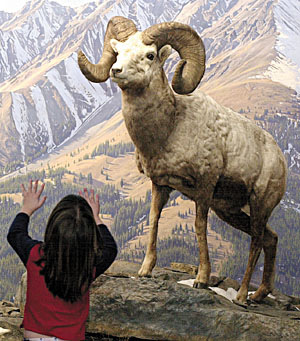Preservation and education are two main goals of Yale's Peabody Museum of
Natural History.
The museum's mission of preservation has its roots in the 18th century, when Yale amassed a miscellaneous assortment of "natural and artificial curiosities" from around the world. In the early 19th century, the mineralogical collections of Yale Professor Benjamin Silliman became a principal attraction for visitors and helped to establish Yale as a major center of scientific education.
The Peabody Museum of Natural History was created in 1866 with a gift from George Peabody. The philanthropist's nephew, paleontologist O.C. Marsh, became the museum's first director and dramatically expanded its holdings with his fossil finds and other archaeological and enthological artifacts.
Today, the Peabody Museum's collections comprise more than 11 million specimens and objects -- including tens of thousands of "types," the original specimens used when a new species of plant or animal was first identified.
These collections are cared for under the supervision of curators in 10 divisions: Anthropology, Paleobotany (which includes Botany), Entomology, Invertebrate Zoology, Invertebrate Paleontology, Vertebrate Zoology (which includes Herpetology, Ichthyology, Mammalogy and Ornithology), Vertebrate Paleontology, Mineralogy, Meteorites and Historical Scientific Instruments. Many of these specimens have been moved to state-of-the-art storage facilities in The Class of 1954 Environmental Science Center, which is adjacent to the building the Peabody has occupied since 1925 (see related story, page 1).
Today, the Peabody's two-story-high Great Hall
features Rudolph Zallinger's Pulitzer Prize-winning "Age of Reptiles" mural, as well as skeletons of such dinosaurs as the giant Brontosaurus (now identified as an Apatosaurus), which was discovered in 1874 by Marsh, and Deinonychus, which was unearthed in 1964 by Yale Professor John Ostrom.
Elsewhere in the museum, nature dioramas and a hands-on Discovery Room complement exhibits on birds, minerals, meteorites, insects and the cultures of ancient Egypt and Native America.
One of New Haven's most popular tourist attractions, the Peabody Museum of Natural History presents numerous educational programs on science and social studies for children and adults. Every year more than 30,000 elementary through high school students from Connecticut, Massachusetts, New York and Rhode Island come to the Peabody for educational tours and programs. The museum is also strengthening the science curriculum in New Haven schools through its Biodiversity and Human Health Program (see story, page 2).
Museum's New Director
Biodiversity expert Michael J. Donoghue will become director of Yale's Peabody Museum of Natural History on Jan. 1, 2003.
Donoghue, the G. Evelyn Hutchinson Professor of Ecology and Evolutionary Biology and chair of the department, is currently the Peabody Museum's curator of botany. Donoghue also has faculty appointments in the Department of Geology and Geophysics and the School of Forestry & Environmental Studies.
"Michael Donoghue's knowledge and understanding of the importance of collections, his passion for reaching the public through exhibitions, and his intellectual distinction will make him a superb director of the Peabody Museum," said President Richard C. Levin in announcing the new director. "He will also ensure that the museum plays an important role in the study and conservation of biodiversity."
Donoghue will succeed Richard Burger, who has served as director of the Peabody Museum for more than seven years. Burger will return to full-time research and teaching as a professor of anthropology and as curator of anthropology at the Peabody Museum.
Contents
Building for State-of-the-Art Research
Inspiring Future Science Leaders
Harnessing the Power of the Genome
Encouraging Women in the Sciences
Forging International Collaborations
Yale Dean Honored With Blue Planet Prize
Engineering the World of Tomorrow
Yale Engineer Receives National Medal of Technology
Promoting the Greening of 'The Blue'
Peabody Museum of Natural History:
Preserving the Past, Educating Future Generations
Bringing Yale Discoveries to The Public
Wright Nuclear Structure Laboratory: Probing the Power of Particles
More Yale Science News
Facilities Far and Near

 SPECIAL
SPECIAL ISSUE
ISSUE 2002-2003
2002-2003 |
| VOLUME 2, NUMBER 1
VOLUME 2, NUMBER 1
